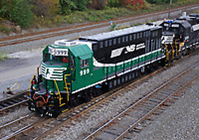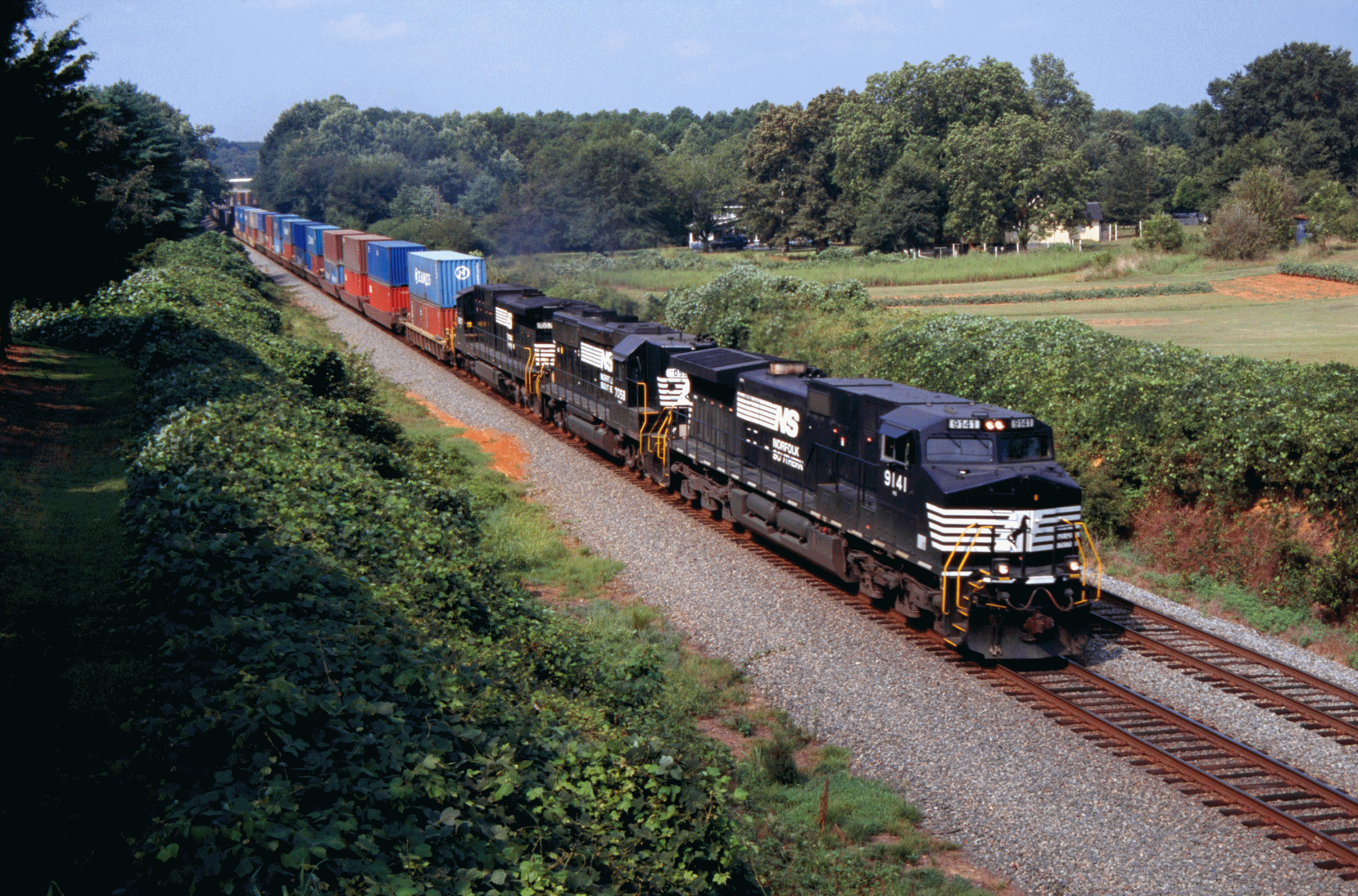 November 2009, Volume 39 No. 3, Page 4
November 2009, Volume 39 No. 3, Page 4
NS Unveils Experimental Electric Locomotive
 ALTOONA, PA. With U.S. Dept. of Transportation Secretary Ray LaHood and Congressman Bill Shuster in attendance,
Norfolk Southern today unveiled the latest in alternative energy locomotive technology at its Juniata Locomotive Shop in
Altoona, Pa. NS 999 is a prototype 1,500-horsepower switching locomotive that relies solely on rechargeable batteries for power.
ALTOONA, PA. With U.S. Dept. of Transportation Secretary Ray LaHood and Congressman Bill Shuster in attendance,
Norfolk Southern today unveiled the latest in alternative energy locomotive technology at its Juniata Locomotive Shop in
Altoona, Pa. NS 999 is a prototype 1,500-horsepower switching locomotive that relies solely on rechargeable batteries for power."At Norfolk Southern we strongly subscribe to the view that sustainability and reducing our carbon footprint are solid business objectives that also provide enormous benefits to the communities we serve," said CEO Wick Moorman. "By utilizing regenerated kinetic energy of the train and with no diesel exhaust emissions, NS 999 achieves those goals. This prototype locomotive was developed by Norfolk Southern, with the help of an incredibly creative partnership, including the U.S. Dept. of Energy, the Federal Railroad Administration, and The Pennsylvania State University, for which we are grateful. We must also recognize Congressman Bill Shuster, as without his active interest and participation in this project NS 999 would still be merely a concept."
"Today, the transportation sector currently accounts for just under a third of U.S. greenhouse gas emissions, more than half of nitrogen oxide emissions, and almost three-quarters of our petroleum consumption. We need to change that," said Secretary LaHood. "By working together to develop alternative energy sources and innovative technologies like this electric locomotive, we will make transportation more sustainable and energy-efficient."
"Historically, Pennsylvania has had a tremendous history in railroading, and it remains my belief that our state can still have a bright future in rail if we take advantage of dynamic partnerships between the private and public sectors like the one that produced this locomotive," said Congressman Bill Shuster, the Ranking Republican on the Railroads Subcommittee. "What Norfolk Southern and Penn State are doing with Congress and Secretary LaHood's support is truly significant and will help usher in a new generation of green locomotives fueled by American ingenuity. Let's not forget about the great work done by the Juniata Locomotive Shop employees who did a superior job producing this engine. I am proud to have worked to secure funding for this project, and I look forward to seeing it working the rail lines soon."
Congressman Shuster secured $1.3 million in federal funding for the NS 999 project.
NS 999 is an entirely electric locomotive that uses a lead-acid energy storage system comprised of 1,080 12-volt batteries to operate in railroad switching applications without the use of a diesel engine and with zero exhaust emissions. The plug-in locomotive also can regenerate dynamic braking energy through a system provided by Brookville Equipment Company. The recovered dynamic braking energy continually replenishes the energy storage system, and uses this recovered energy for tractive effort in rail operations. The batteries are carefully monitored and controlled through an elaborate battery management system to assure safety and maximum battery life, and when fully charged NS 999 is able to operate three shifts before recharging is required.
For those wishing to model the new locomotive, it is built on a former GP-38. Good news: you will not need a sound decoder!
NS is Raising the Roof
 Opening a new rail gateway for double-stacked containers is taking place across southern West Virginia 20 grueling feet at a time, according to
the Charleston Daily Mail. Every weekday, Norfolk Southern shuts down a portion of its main line between the East Coast and the Midwest
so crews can raise the roofs in the line's tunnels. It's part of the $151-million Heartland Corridor project, which will allow the railroad to
ship double-stacked containers between the port of Hampton Roads and Chicago. The project will cut 233 miles and more than a day's travel time
for trains moving between the two locations.
Opening a new rail gateway for double-stacked containers is taking place across southern West Virginia 20 grueling feet at a time, according to
the Charleston Daily Mail. Every weekday, Norfolk Southern shuts down a portion of its main line between the East Coast and the Midwest
so crews can raise the roofs in the line's tunnels. It's part of the $151-million Heartland Corridor project, which will allow the railroad to
ship double-stacked containers between the port of Hampton Roads and Chicago. The project will cut 233 miles and more than a day's travel time
for trains moving between the two locations."Big Sandy 1," near here, is one of the tunnels where work is under way. The nearly half-mile-long tunnel has a concrete liner. The sides and arched roof are smooth and, to the naked eye, seem perfect. "The workmanship is 104 years old," said Robert Billingsley, Norfolk Southern's director of structural projects. "It's pretty darned good!" But the distance from the top of the rails to the roof is 19 feet, 6 inches. Double-stacked containers are 20 feet, 3 inches tall. The railroad wants a 9-inch safety margin so it is having the height raised to 21 feet.
At 2 a.m. each weekday contractors enter the tunnel on rubber-tired aerial lifts or rail flatcars loaded with equipment. Wearing facemasks, helmets with lamps and coal-mining overalls with reflective stripes, the workers maneuver the lifts high above the tracks and start sawing the liner where the straight, smooth sides begin to arch. Billingsley said that when Heartland Corridor work began two years ago, workers didn't make much progress in one shift. Now they typically finish a 20-foot section in one shift.
Every time the workers move equipment, they blow horns to alert everyone. That's a good precaution because space between the flatcars and the tunnel walls is tight, it's pitch dark, and you can't easily be heard. The noise made by the equipment is magnified as it reverberates off the tunnel's walls. After the workers saw through a 20-foot length of liner, they use a machine called a "road header" - a drum encrusted with drill bits - to rip out the arched portion of the liner, raising the tunnel's height. Sometimes it rains grit in the dark. No wonder road headers have been featured in the Discovery Channel's "Dirty Jobs" television show. A fan is installed at one end of the tunnel to blow fresh air past the workers.
There aren't any cave-ins because another crew preceded the workers, drilling 20-foot-long roof bolt holes in a carefully laid out pattern: six bolts across, six feet apart. The bolts are installed as soon as the cutting crew passes. The sides don't collapse because they've already been reinforced with 8- to 16-foot-long bolts. The shift is finished after a crew sprays liquid concrete on the freshly cut roof to stabilize it. Instead of a smooth concrete arch, the heightened roof looks like a moonscape. The roof must be secured and the tunnel cleared by noon, when the rail line reopens. On a typical morning trains can be seen idling on tracks near the tunnel, waiting for the reopening.
Billingsley said a lot of preparation work is done before crews even begin to raise a roof. Ballast is spread over the tunnel floor up to the height of the rails so workers don't have to stumble over ties or through mud and rubber-tired vehicles as well as rail equipment can operate.
"Holes are drilled to determine how thick the liner is, whether there are any voids, and to determine the quality of rock," he said. "We put a camera up every hole and document what is found." Usually there's sandstone behind the liner but crews have found shale, a few coal seams and, occasionally, a void.
"In the Cooper Tunnel near Bramwell they discovered a 20-foot void over the roof liner," Billingsley said. "They're building a steel arch liner to secure the space." After a roof is raised, crews spray a thick finishing coat of liquid concrete on it. Then Norfolk Southern workers replace the ballast, rails and ties.
Some tunnels require special work. U.S. Route 52 runs atop one end of Big Sandy 1 and an abandoned portion of Route 52 runs across the top of the other end. Billingsley said both ends of the tunnel would be reinforced with steel to make sure the roadways above are secure.
A total of 28 tunnels - four in Virginia and 24 in West Virginia - are being modified. Workers have encountered a variety of issues. Two tunnels are lined with brick. One is natural rock. Most were drilled through sandstone but at least one in Virginia was drilled through limestone.
In some cases the track has been lowered instead of raising the roof. But this isn't common because the job shuts down the line for an extended period. In some of the tunnels the entire roof doesn't need to be raised. Instead, the side of the liner can be notched to provide adequate clearance.
Billingsley said safety is the railroad's top priority and there haven't been any serious injuries. "During the two years there's been one accident that delayed a train," he said. "That was due to a rock fall - one rock."
The tunnel work began on Oct. 20, 2007, at the Cowan Tunnel near Radford, Va. The Williamson (Mingo) Tunnel was completed in December 2009. Four tunnels in the area are expected to be finished in 2010: The Cooper Tunnel in January, Big Sandy 4 in June, Big Sandy 3 in July and Big Sandy 1 in August.
LRL Construction of Tillamook, Ore., is working on the Cooper Tunnel. Johnson Western Constructors of San Leandro, Calif., worked on the Williamson (Mingo) Tunnel and is working on Big Sandy 1 and 3. R.J. Corman Railroad Construction of Nicholasville, Ky., is working on Big Sandy 4. The West Coast companies brought some managers to the projects but hired mostly local people, including many with mining experience, Billingsley said. A crew typically consists of 25 to 30 workers.
Robin Chapman, NS manager of public relations, said the company's line across southern West Virginia - "The N Line" - "was built to move coal." It handles less coal than in the past but also handles mixed freight and, currently, one single-stack train each day. "Double stacks will double our capacity," he said.
Funding for the Heartland Corridor includes $95 million from the federal government, $51 million from Norfolk Southern, $5 million from the state of Virginia and $800,000 from the state of Ohio. Norfolk Southern donated 78 acres at Prichard in Wayne County for an $18 million terminal that is being developed by the West Virginia Public Port Authority. Ohio already has a terminal operating near Columbus. Proponents say the Heartland Corridor will provide an efficient alternative to trucks and will reduce highway congestion.